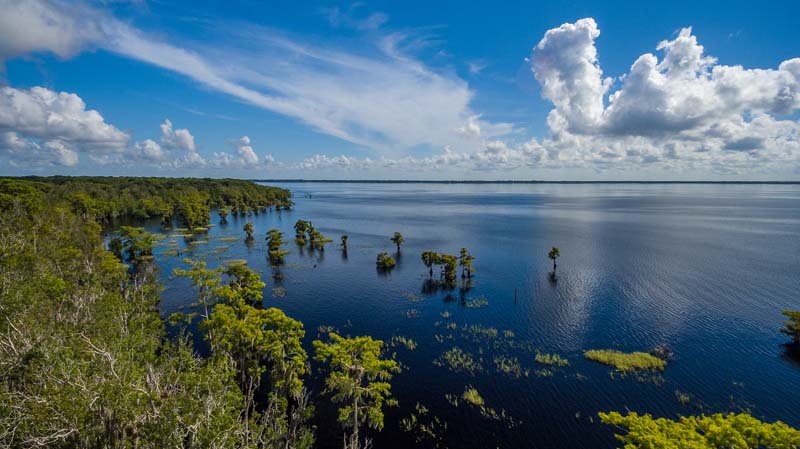The Indian River County Commission has hired an engineering firm to analyze Blue Cypress Lake’s deteriorating water quality.
Long regarded as one of Indian River County’s crown jewels, the once-pristine lake – located about 20 miles west of Vero and surrounded by 29,000 acres of marshes, swamps and cypress forests – had until recently seemed protected by its remoteness.
But earlier this summer, the lake erupted with a toxic algae bloom, joining the Indian River Lagoon and Lake Okeechobee further south on the sick list.
While the dark blue waters of the lake still appear pristine from the air, a closer look in some areas reveals green pieces of algae floating beneath the surface.
Jones Edmunds and Associates, with offices in Gainesville, Titusville and Tampa, was hired to perform the pollution analysis for $63,500, with a mandate to report its conclusions and recommendations by the end of the year.
Much of the company’s work will involve coordinating with the Florida Department of Environmental Protection and St. Johns River Water Management District. Both agencies are still discussing testing protocols for determining the source of pollution.
Indian River County Utilities Director Vincent Burke said FDEP and SJRWMD are taking a “holistic” approach, not just considering the recent increase in treated human waste applied on farms near the lake, but also whether “legacy load” chemicals from fertilizer are migrating from Osceola County and polluting the 6,555-acre lake.
The water quality started deteriorating five or six years ago, Burke said, which pre-dates increased application of biosolids – a polite name for the output of sewage plants – on nearby farms.
Chemicals such as nitrogen and phosphorous that can come from either fertilizer or human waste have begun to feed algae blooms in the lake, some toxic, that cloud the water and consume oxygen, undermining the aquatic environment.
Acetaminophen, hydrocodone and sucralose are being considered by FDEP and SJRWMD as human waste markers that could tell scientists and policymakers if the pollution is coming from biosolids, Burke said.
Sucralose, which is found in human waste, doesn’t break down readily, and should provide a traceable path of biosolid runoff into the lake, if that occurred. No biosolids have been applied near the lake since May.
Jones Edmunds has been tasked with finding the cause of lake pollution by the end of the year, when it will give a presentation to the county commission and public.
The reporting deadline was set to beat the end of a six-month moratorium on human waste application, which was passed by the county in July and expires in January.
The county must have evidence that biosolids are polluting the lake before extending its ban on their use as fertilizer or face accusations of interrupting farming operations, which are protected under the state farming act.
The thousands of tons of biosolids dumped on Indian River County farm fields are coming from South Florida governmental entities that pay farmers to take them. Indian River County doesn’t sell its own biosolids, but rather disposes them in the county landfill.
The increase in biosolids application here began after the use of the material was banned in watersheds to the south for ecological reasons.

